2017 MERCEDES-BENZ S-Class COUPE lock
[x] Cancel search: lockPage 23 of 338

Sidewall (definition) ....................... 321
Snow chains .................................. 305
Speed rating (definition) ................ 320
Storing ........................................... 322
Structure and characteristics
(definition) ..................................... 319
Summer tires in winter .................. 305
Temperature .................................. 316
TIN (Tire Identification Number)
(definition) ..................................... 321
Tire bead (definition) ...................... 321
Tire pressure (definition) ................ 321
Tire pressures (recommended) ...... 320
Tire size (data) ............................... 326
Tire size designation, load-bearing
capacity, speed rating .................... 316
Tire tread ....................................... 304
Tire tread (definition) ..................... 321
Total load limit (definition) ............. 321
Traction ......................................... 315
Traction (definition) ....................... 321
Tread wear ..................................... 315
Uniform Tire Quality Grading
Standards ...................................... 315
Uniform Tire Quality Grading
Standards (definition) .................... 319
Wear indicator (definition) ............. 321
Wheel and tire combination ........... 326
Wheel rim (definition) .................... 320
see Flat tire
Top Tether ............................................ 60
Touchpad
Changing the station/music
track .............................................. 245
Character suggestions ................... 244
Deleting characters ....................... 245
Entering a space ............................ 245
Entering characters ....................... 244
Gesture control .............................. 244
Handwriting recognition ................ 245
Operating the touchpad ................. 244
Overview ........................................ 244
Quick access for Audio .................. 245
Quick access for telephone ........... 245
Switching ....................................... 244
Switching input line ....................... 245
Tow-starting
Emergency engine starting ............ 300 Important safety notes .................. 298
Towing away
Important safety guidelines ........... 298
Installing the towing eye ................ 299
No
tes for 4MATIC vehicles ............ 300
Removing the towing eye ............... 299
Transporting the vehicle ................ 300
With both axles on the ground ....... 299
Towing eye ......................................... 288
Traffic reports
see also Digital Operator's Man-
ual .................................................. 242
Traffic Sign Assist
Activating ....................................... 176
Display message ............................ 223
Function/notes ............................. 176
Important safety notes .................. 176
Instrument cluster display ............. 177
Switching on/off ........................... 198
Transfer case ..................................... 135
Transmission
see Automatic transmission
Transporting the vehicle .................. 300
Trim pieces (cleaning instruc-
tions) .................................................. 286
Trip computer (on-board com-
puter) .................................................. 191
Trip odometer
Calling up ....................................... 190
Resetting (on-board computer) ...... 191
Trunk
Emergency release .......................... 84
Emergency release button ............... 85
Important safety notes .................... 80
Locking separately ........................... 84
Opening ........................................... 81
Opening/closing (automatically
from inside) ...................................... 83
Opening/closing (automatically
from outside) ................................... 81
Opening/closing (from outside,
HANDS-FREE ACCESS) .................... 82
Power closing .................................. 79
Trunk lid
Display message ............................ 229
Obstacle recognition ........................ 80
Opening dimensions ...................... 335
Index21
Page 24 of 338

Opening/closing .............................. 80
Trunk load (maximum) ......................335
Turn signals
Display message ............................ 215
Switching on/off ........................... 105
Two-way radio
Frequencies ................................... 328
Installation ..................................... 328
Transmission output (maximum) .... 328
Windshield (infrared reflective) ...... 272
Type identification plate
see Vehicle identification plate
U
UnlockingEmergency unlocking ....................... 79
From inside the vehicle (central
unlocking button) .............................7 8
Upshift indicator (on-board com-
puter, Mercedes-AMG vehicles) .......202
USB devices
Connecting to the Media Inter-
face ............................................... 251
V
Vanity mirror (in the sun visor) ........258
Vehicle
Correct use ...................................... 29
Data acquisition ............................... 30
Display message ............................ 227
Equipment ....................................... 26
Individual settings .......................... 197
Limited Warranty .............................3 0
Loading .......................................... 312
Locking (in an emergency) ............... 79
Locking (SmartKey) .......................... 72
Lowering ........................................ 326
Maintenance .................................... 27
Operating safety .............................. 28
Parking .......................................... 137
Parking for a long period ................ 140
Pulling away ................................... 124
Raising ........................................... 323
Reporting problems ......................... 29
Securing from rolling away ............ 322
Towing away .................................. 298 Transporting .................................. 300
Unlocking (in an emergency) ........... 79
Unlocking (SmartKey) ...................... 72
Vehicle data ................................... 335
Vehicle dimensions ........................... 335
Vehicle emergency locking ................ 79
Vehicle identification number
see VIN
Vehicle identification plate .............. 329
Vehicle level
Active Body Control ABC ............... 156
AIRMATIC ...................................... 158
Display message ............................ 219
Vehicle tool kit .................................. 288
Video
Operating the DVD ......................... 195
see also Digital Operator's Man-
ual .................................................. 242
Video-AUX
Connecting an external video
source ............................................ 252
VIN
Type plate ...................................... 329
W
Warning and indicator lampsABS ................................................ 234
Brakes ........................................... 233
Check Engine ................................. 237
Coolant .......................................... 237
Distance warning ........................... 239
ESP
®.............................................. 234
ESP®OFF ....................................... 236
Fuel tank ........................................ 237
General notes ................................ 231
Overview .......................................... 34
Parking brake ................................ 236
PASSENGER AIR BAG ...................... 42
Reserve fuel ................................... 237
Restraint system ............................ 236
Seat belt ........................................ 232
Steering ......................................... 241
Tire pressure monitor .................... 240
Warranty .............................................. 26
Washer fluid
Display message ............................ 230
22Index
Page 35 of 338
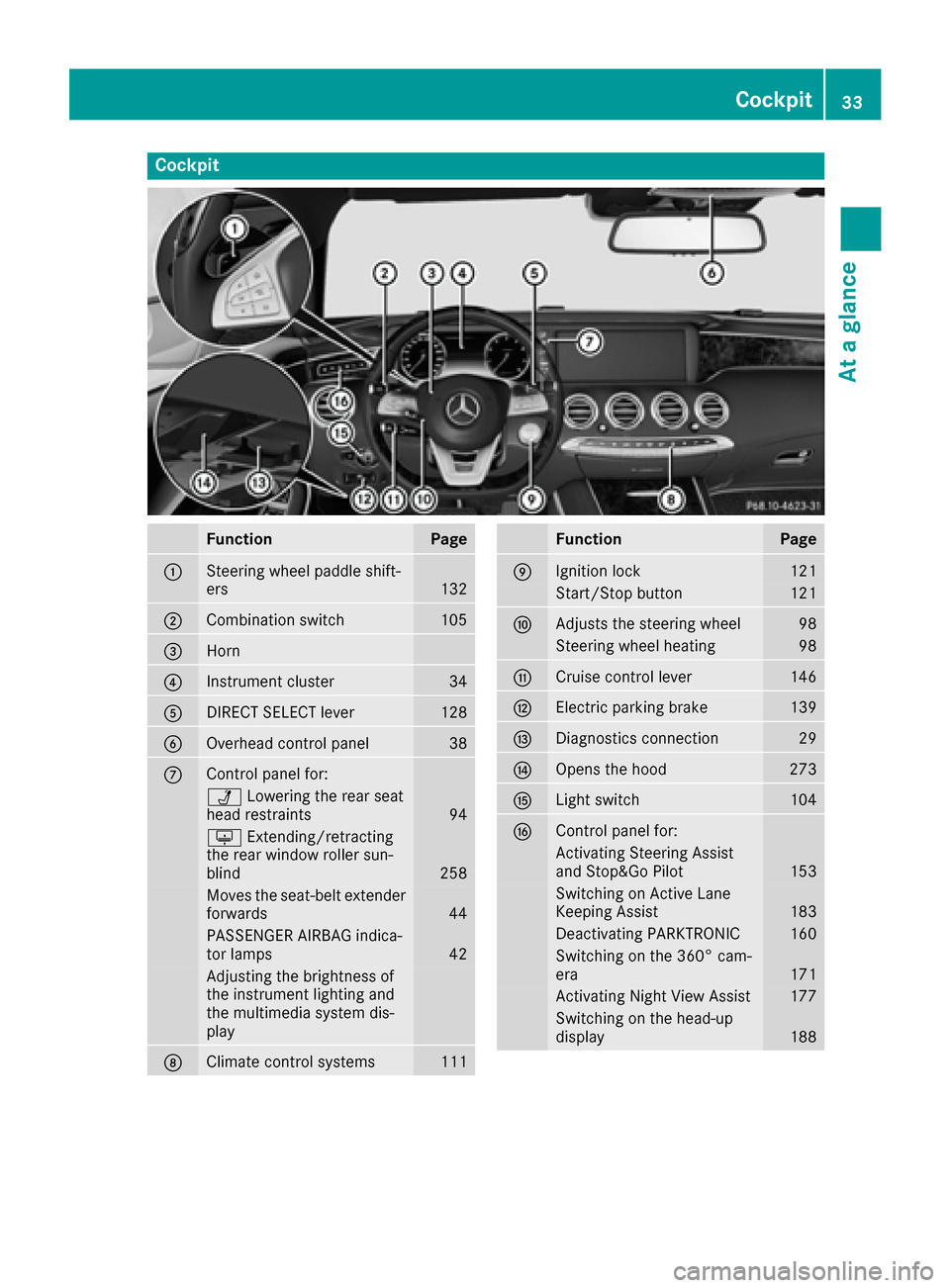
Cockpit
FunctionPage
0043Steering wheel paddle shift-
ers132
0044Combination switch105
0087Horn
0085Instrument cluster34
0083DIRECT SELECT lever128
0084Overhead control panel38
006BControl panel for:
00CALowering the rear seat
head restraints94
0094 Extending/retracting
the rear window roller sun-
blind
258
Moves the seat-belt extender
forwards44
PASSENGER AIRBAG indica-
tor lamps42
Adjusting the brightness of
the instrument lighting and
the multimedia system dis-
play
006CClimate control systems111
FunctionPage
006DIgnition lock121
Start/Stop button121
006EAdjusts the steering wheel98
Steering wheel heating98
006FCruise control lever146
0070Electric parking brake139
0071Diagnostics connection29
0072Opens the hood273
0073Light switch104
0074Control panel for:
Activating Steering Assist
and Stop&Go Pilot153
Switching on Active Lane
Keeping Assist183
Deactivating PARKTRONIC160
Switching on the 360° cam-
era171
Activating Night View Assist177
Switching on the head-up
display188
Cockpit33
At a glance
Page 41 of 338
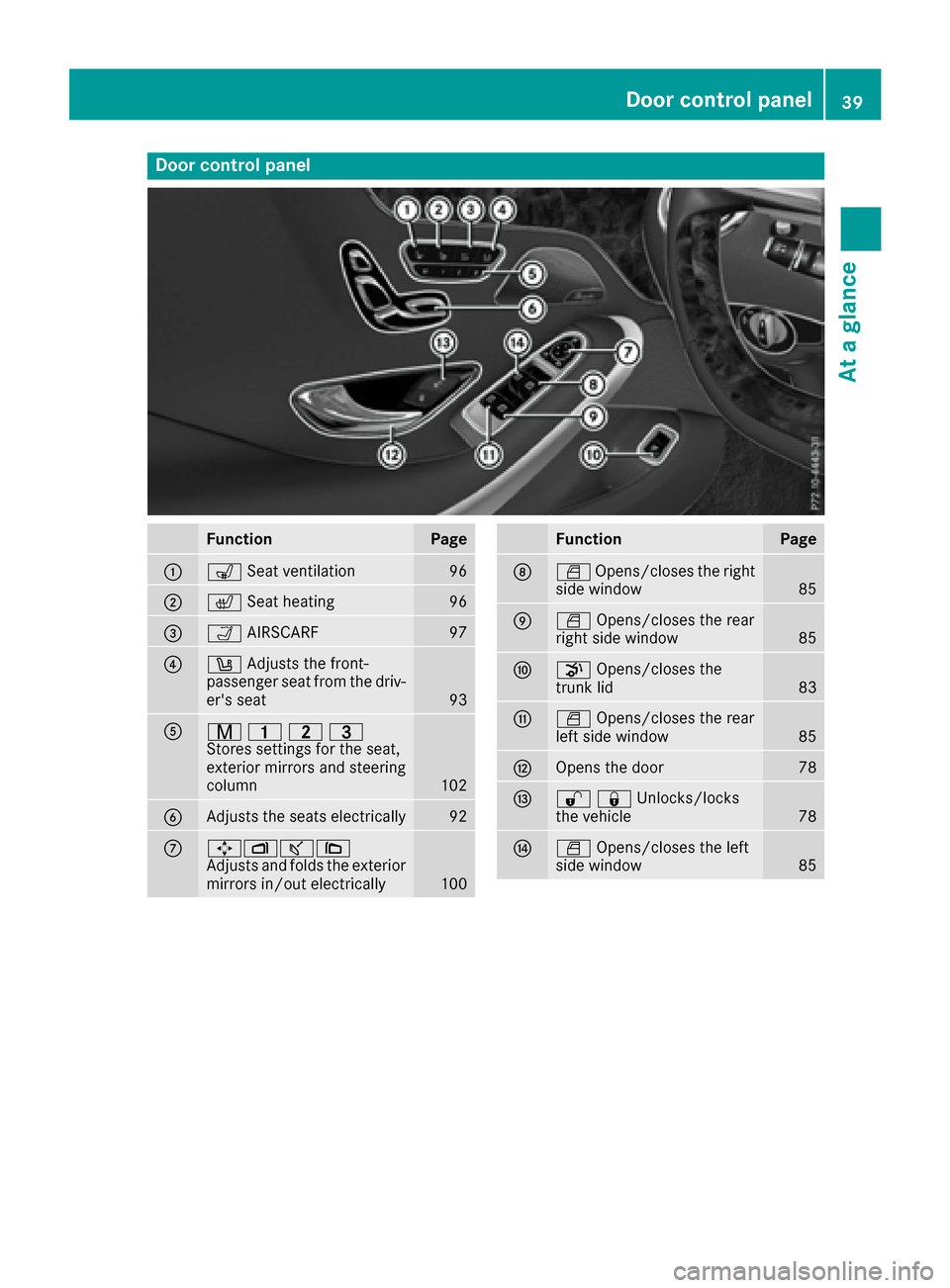
Door controlpanel
FunctionPage
0043008E Seat ventilation96
00440072Seat heatin g96
008700CEAIRSCARF97
00850096Adjust sth efront-
passenger seat from th edriv-
er' sseat
93
0083008D 003700380040
Stores settings for the seat,
exterior mirrors and steering
column
102
0084Adjusts the seats electrically92
006B0062007000AD0071
Adjusts and folds the exterior
mirrors in/out electrically
100
FunctionPage
006C0062 Opens/closes the right
side window85
006D0062 Opens/closes the rear
right side window85
006E008B Opens/closes the
trunk lid83
006F0062 Opens/closes the rear
left side window85
0070Opens the door78
007100360037Unlocks/locks
the vehicle78
00720062 Opens/closes the left
side window85
Door control panel39
At a glance
Page 43 of 338
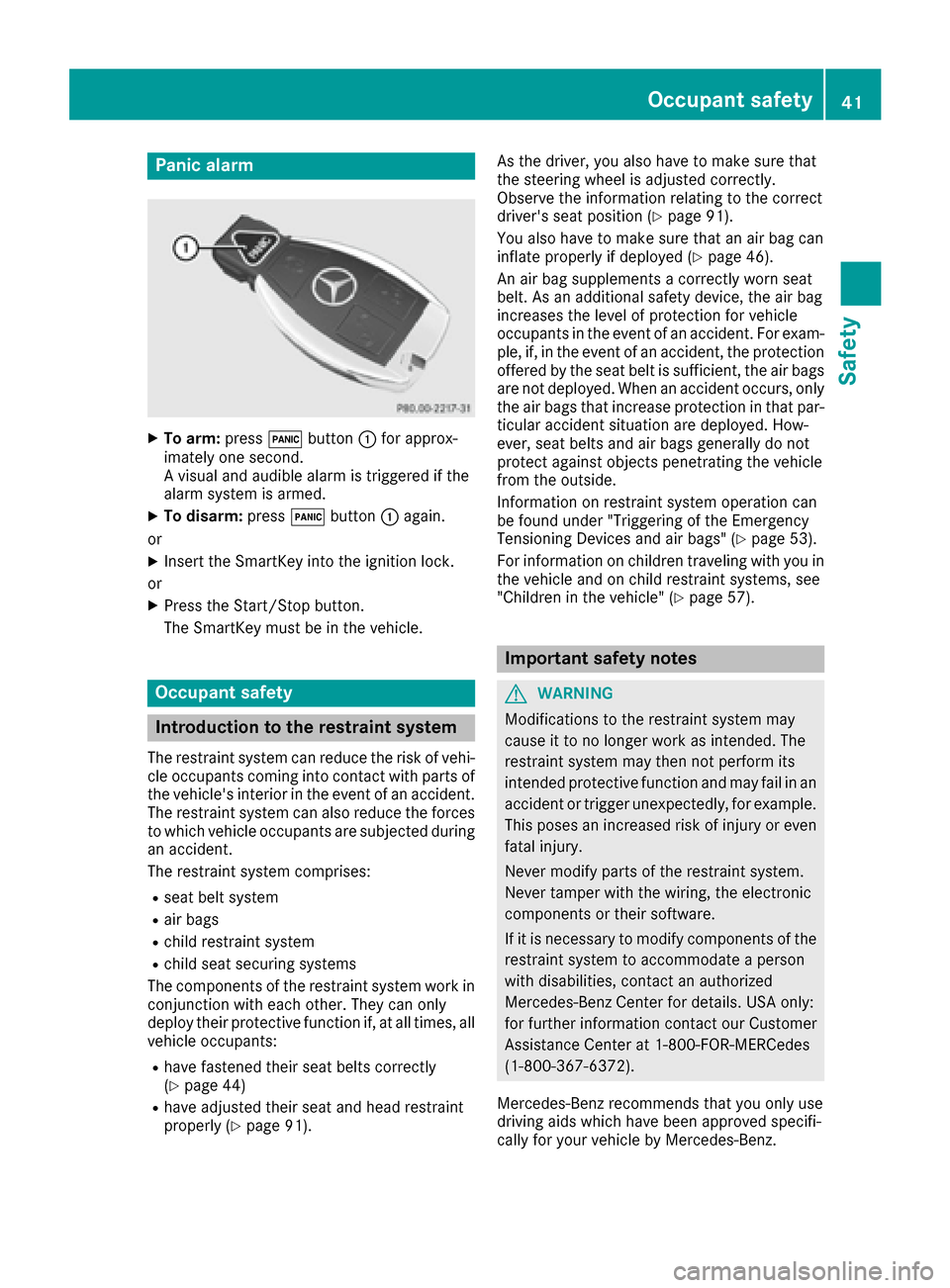
Panic alarm
XTo arm:press0033button 0043for approx-
imately one second.
A visual and audible alarm is triggered if the
alarm system is armed.
XTo disarm: press0033button 0043again.
or
XInsert the SmartKey into the ignition lock.
or
XPress the Start/Stop button.
The SmartKey must be in the vehicle.
Occupant safety
Introduction to the restraint system
The restraint system can reduce the risk of vehi- cle occupants coming into contact with parts of
the vehicle's interior in the event of an accident.
The restraint system can also reduce the forces to which vehicle occupants are subjected during
an accident.
The restraint system comprises:
Rseat belt system
Rair bags
Rchild restraint system
Rchild seat securing systems
The components of the restraint system work in
conjunction with each other. They can only
deploy their protective function if, at all times, all vehicle occupants:
Rhave fastened their seat belts correctly
(Ypage 44)
Rhave adjusted their seat and head restraint
properly (Ypage 91). As the driver, you also have to make sure that
the steering wheel is adjusted correctly.
Observe the information relating to the correct
driver's seat position (
Ypage 91).
You also have to make sure that an air bag can
inflate properly if deployed (
Ypage 46).
An air bag supplements a correctly worn seat
belt. As an additional safety device, the air bag
increases the level of protection for vehicle
occupants in the event of an accident. For exam-
ple, if, in the event of an accident, the protection
offered by the seat belt is sufficient, the air bags are not deployed. When an accident occurs, only
the air bags that increase protection in that par-ticular accident situation are deployed. How-
ever, seat belts and air bags generally do not
protect against objects penetrating the vehicle
from the outside.
Information on restraint system operation can
be found under "Triggering of the Emergency
Tensioning Devices and air bags" (
Ypage 53).
For information on children traveling with you in
the vehicle and on child restraint systems, see
"Children in the vehicle" (
Ypage 57).
Important safety notes
GWARNING
Modifications to the restraint system may
cause it to no longer work as intended. The
restraint system may then not perform its
intended protective function and may fail in an
accident or trigger unexpectedly, for example.
This poses an increased risk of injury or even fatal injury.
Never modify parts of the restraint system.
Never tamper with the wiring, the electronic
components or their software.
If it is necessary to modify components of the
restraint system to accommodate a person
with disabilities, contact an authorized
Mercedes-Benz Center for details. USA only:
for further information contact our Customer
Assistance Center at 1-800-FOR-MERCedes
(1‑800‑367‑6372).
Mercedes-Benz recommends that you only use
driving aids which have been approved specifi-
cally for your vehicle by Mercedes-Benz.
Occupant safety41
Safety
Z
Page 45 of 338
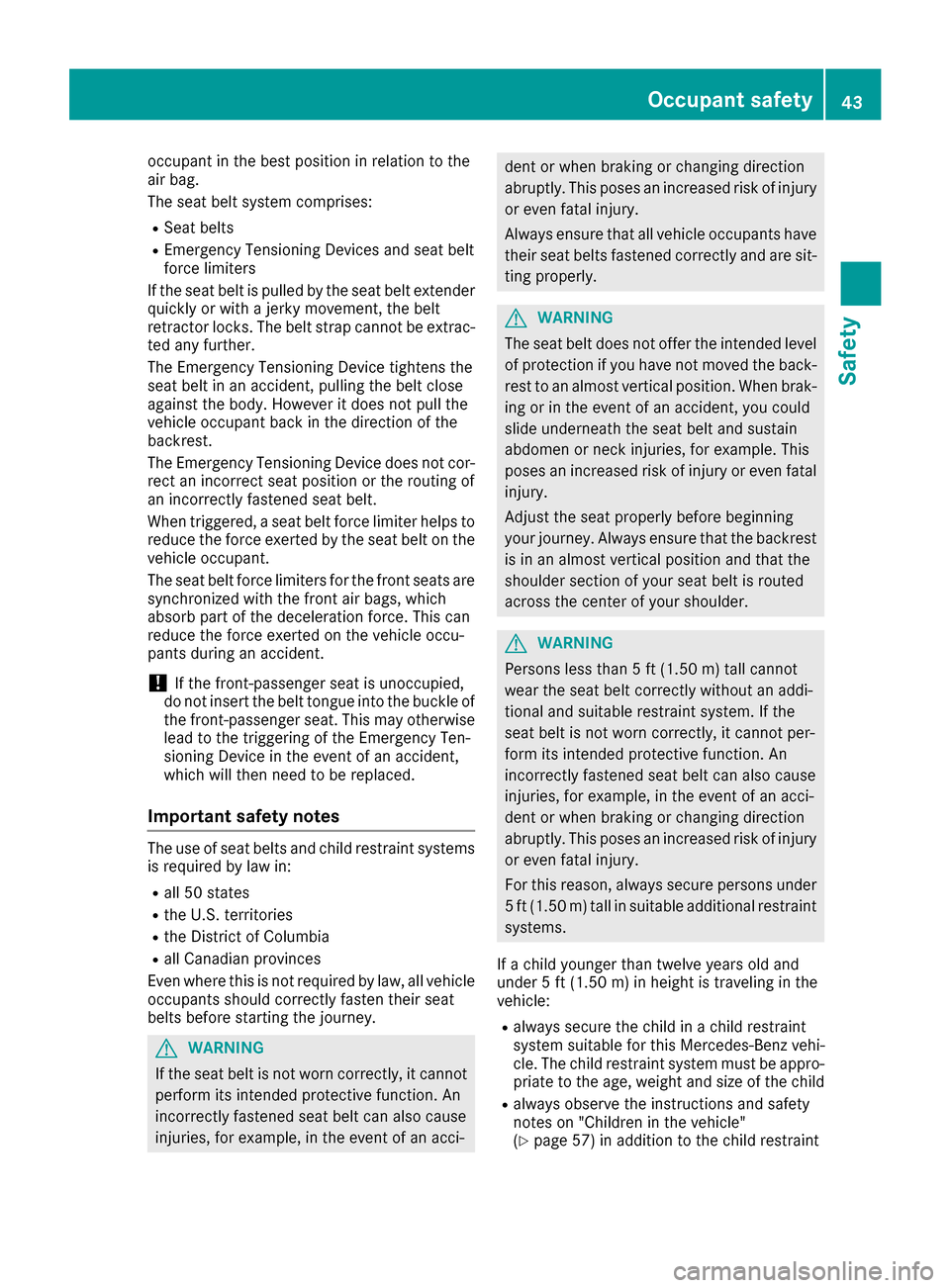
occupant in the best position in relation to the
air bag.
The seat belt system comprises:
RSeat belts
REmergency Tensioning Devices and seat belt
force limiters
If the seat belt is pulled by the seat belt extender
quickly or with a jerky movement, the belt
retractor locks. The belt strap cannot be extrac-
ted any further.
The Emergency Tensioning Device tightens the
seat belt in an accident, pulling the belt close
against the body. However it does not pull the
vehicle occupant back in the direction of the
backrest.
The Emergency Tensioning Device does not cor-
rect an incorrect seat position or the routing of
an incorrectly fastened seat belt.
When triggered, a seat belt force limiter helps to
reduce the force exerted by the seat belt on the
vehicle occupant.
The seat belt force limiters for the front seats are
synchronized with the front air bags, which
absorb part of the deceleration force. This can
reduce the force exerted on the vehicle occu-
pants during an accident.
!If the front-passenger seat is unoccupied,
do not insert the belt tongue into the buckle of
the front-passenger seat. This may otherwise
lead to the triggering of the Emergency Ten-
sioning Device in the event of an accident,
which will then need to be replaced.
Important safety notes
The use of seat belts and child restraint systems
is required by law in:
Rall 50 states
Rthe U.S. territories
Rthe District of Columbia
Rall Canadian provinces
Even where this is not required by law, all vehicle
occupants should correctly fasten their seat
belts before starting the journey.
GWARNING
If the seat belt is not worn correctly, it cannot
perform its intended protective function. An
incorrectly fastened seat belt can also cause
injuries, for example, in the event of an acci-
dent or when braking or changing direction
abruptly. This poses an increased risk of injury or even fatal injury.
Always ensure that all vehicle occupants have
their seat belts fastened correctly and are sit-
ting properly.
GWARNING
The seat belt does not offer the intended level of protection if you have not moved the back-
rest to an almost vertical position. When brak-
ing or in the event of an accident, you could
slide underneath the seat belt and sustain
abdomen or neck injuries, for example. This
poses an increased risk of injury or even fatal injury.
Adjust the seat properly before beginning
your journey. Always ensure that the backrest
is in an almost vertical position and that the
shoulder section of your seat belt is routed
across the center of your shoulder.
GWARNING
Persons less than 5 ft (1.50 m) tall cannot
wear the seat belt correctly without an addi-
tional and suitable restraint system. If the
seat belt is not worn correctly, it cannot per-
form its intended protective function. An
incorrectly fastened seat belt can also cause
injuries, for example, in the event of an acci-
dent or when braking or changing direction
abruptly. This poses an increased risk of injury or even fatal injury.
For this reason, always secure persons under
5 ft (1.50 m) tall in suitable additional restraint
systems.
If a child younger than twelve years old and
under 5 ft (1.50 m) in height is traveling in the
vehicle:
Ralways secure the child in a child restraint
system suitable for this Mercedes-Benz vehi-
cle. The child restraint system must be appro-
priate to the age, weight and size of the child
Ralways observe the instructions and safety
notes on "Children in the vehicle"
(
Ypage 57) in addition to the child restraint
Occupant safety43
Safety
Z
Page 47 of 338
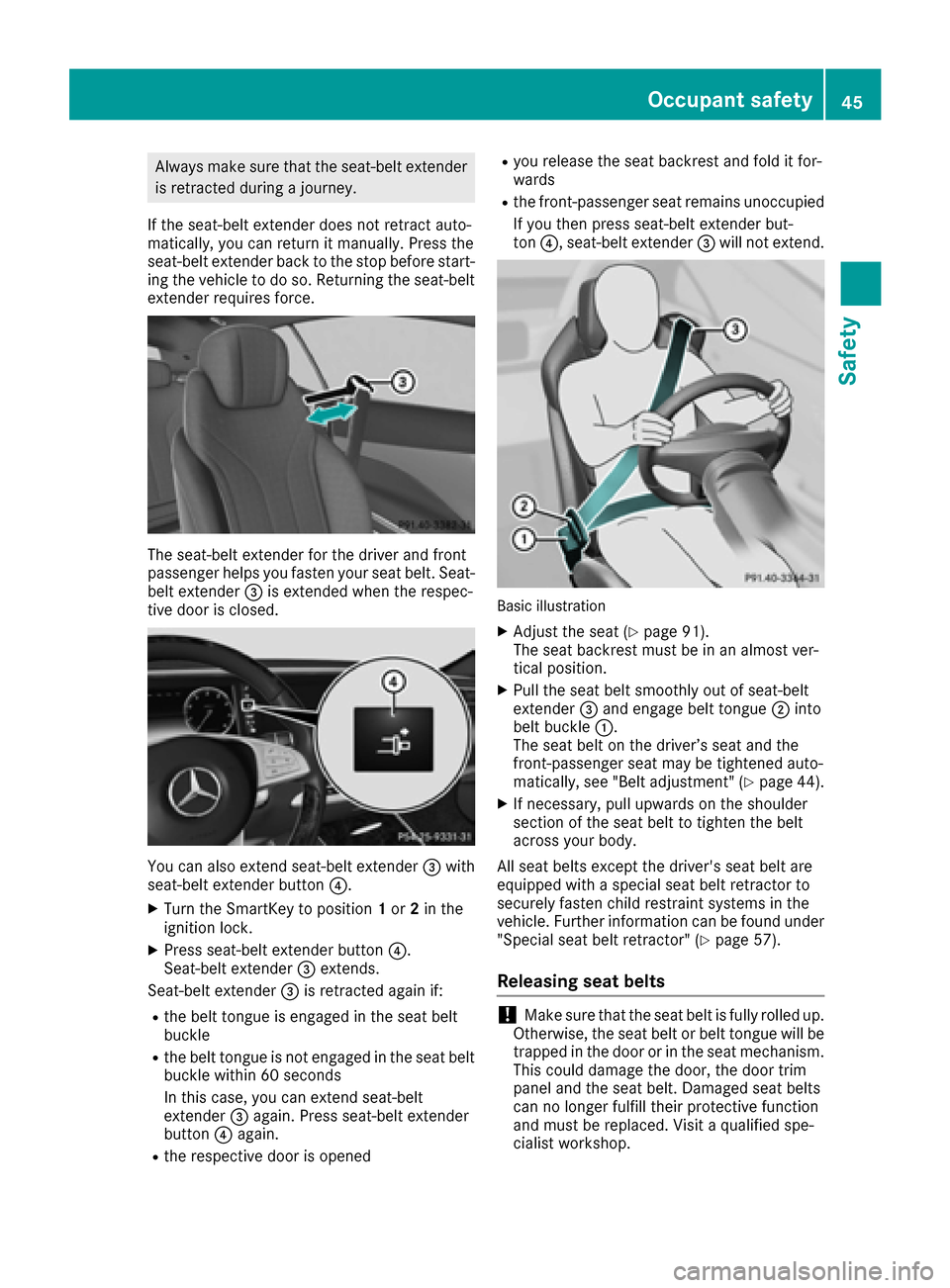
Always make sure that the seat-belt extenderis retracted during a journey.
If the seat-belt extender does not retract auto-
matically, you can return it manually. Press the
seat-belt extender back to the stop before start-
ing the vehicle to do so. Returning the seat-belt
extender requires force.
The seat-belt extender for the driver and front
passenger helps you fasten your seat belt. Seat-
belt extender 0087is extended when the respec-
tive door is closed.
You can also extend seat-belt extender 0087with
seat-belt extender button 0085.
XTurn the SmartKey to position 1or 2in the
ignition lock.
XPress seat-belt extender button 0085.
Seat-belt extender 0087extends.
Seat-belt extender 0087is retracted again if:
Rthe belt tongue is engaged in the seat belt
buckle
Rthe belt tongue is not engaged in the seat belt
buckle within 60 seconds
In this case, you can extend seat-belt
extender 0087again. Press seat-belt extender
button 0085again.
Rthe respective door is opened
Ryou release the seat backrest and fold it for-
wards
Rthe front-passenger seat remains unoccupied
If you then press seat-belt extender but-
ton 0085, seat-belt extender 0087will not extend.
Basic illustration
XAdjust the seat (Ypage 91).
The seat backrest must be in an almost ver-
tical position.
XPull the seat belt smoothly out of seat-belt
extender 0087and engage belt tongue 0044into
belt buckle 0043.
The seat belt on the driver’s seat and the
front-passenger seat may be tightened auto-
matically, see "Belt adjustment" (
Ypage 44).
XIf necessary, pull upwards on the shoulder
section of the seat belt to tighten the belt
across your body.
All seat belts except the driver's seat belt are
equipped with a special seat belt retractor to
securely fasten child restraint systems in the
vehicle. Further information can be found under
"Special seat belt retractor" (
Ypage 57).
Releasing seat belts
!Make sure that the seat belt is fully rolled up.
Otherwise, the seat belt or belt tongue will be
trapped in the door or in the seat mechanism.
This could damage the door, the door trim
panel and the seat belt. Damaged seat belts
can no longer fulfill their protective function
and must be replaced. Visit a qualified spe-
cialist workshop.
Occupant safety45
Safety
Z
Page 52 of 338

0043PASSENGER AIR BAG ON indicator lamp
0044PASSENGER AIR BAG OFF indicator lamp
The indicator lamps inform you whether the
front-passenger front air bag is deactivated or
enabled.
XPress the Start/Stop button once or twice, or
turn the SmartKey to position 1or 2in the
ignition lock.
The system carries out self-diagnostics.
The PASSENGER AIR BAG OFF and PASSENGER
AIR BAG ON indicator lamps must light up simul-
taneously for approximately six seconds.
The indicator lamps display the status of the
front-passenger front air bag.
RPASSENGER AIR BAG ON lights up for 60 sec-
onds, subsequently both indicator lamps are
off (PASSENGER AIR BAG ON and OFF): the
front-passenger front air bag is able to deploy
in the event of an accident.
RPASSENGER AIR BAG OFF lights up: the front-
passenger front air bag is deactivated. It will
then not be deployed in the event of an acci-
dent.
If the PASSENGER AIR BAG ON indicator lamp is off, only the PASSENGER AIR BAG OFF indicator
lamp shows the status of the front-passenger
front air bag. The PASSENGER AIR BAG OFF
indicator lamp may be lit continuously or be off.
If the status of the front-passenger front air bagchanges while the vehicle is in motion, an air bag
display message appears in the instrument clus- ter (
Ypage 213). When the front-passenger
seat is occupied, always pay attention to the
PASSENGER AIR BAG OFF indicator lamp. Be
aware of the status of the front-passenger front
air bag both before and during the journey.
GWARNING
If the PASSENGER AIR BAG OFF indicator
lamp is lit, the front-passenger front air bag is
disabled. It will not be deployed in the event of an accident and cannot perform its intended
protective function. A person in the front-
passenger seat could then, for example, come
into contact with the vehicle's interior, espe-
cially if the person is sitting too close to the
dashboard. This poses an increased risk of
injury or even fatal injury.
When the front-passenger seat is occupied,
always ensure that:
Rthe classification of the person in the front-passenger seat is correct and the front-
passenger front air bag is enabled or disa-
bled in accordance with the person in the
front-passenger seat
Rthe front-passenger seat has been moved
back as far back as possible.
Rthe person is seated correctly.
Make sure, both before and during the jour-
ney, that the status of the front-passenger
front air bag is correct.
GWARNING
If you secure a child in a rearward-facing child
restraint system on the front-passenger seat
and the PASSENGER AIR BAG OFF indicator
lamp is off, the front-passenger front air bag
may deploy in the event of an accident. The
child could be struck by the air bag. This poses an increased risk of injury or even fatal injury.
Make sure that the front-passenger front air
bag has been disabled. The PASSENGER AIR
BAG OFF indicator lamp must be lit.
If the PASSENGER AIR BAG OFF indicator lamp
stays off, do not install a rearward-facing child
restraint system on the front-passenger seat.
You can find more information on OCS under
"Problems with the Occupant Classification Sys-
tem" (
Ypage 53).
50Occupant safety
Safety